You have no items in your cart.
Making Toys New Again and Again

As homeschoolers, our whole homes are “classrooms”. They store art supplies, math books, science experiments, practical life tools, libraries and toys… toys… toys… Setting up a homeschool that nurtures creativity, fosters curiosity and instills order can be a very daunting task. Making sure that toys live many lives (through rotation) can make a big difference.
By no means do I have this all figured out. I have, however, come to a place where I am more or less satisfied with how we approach toys. I am sure that this system will get better as I become more seasoned, more in-tune with who we are as a family and more comfortable with “less is more.”
While we do not have a “classroom” or a “playroom,” we do have dedicated space to learning tools. Between our basement study and our children’s room, we have a small alcove which is just perfect for some organization. In this space we have 2 stations. 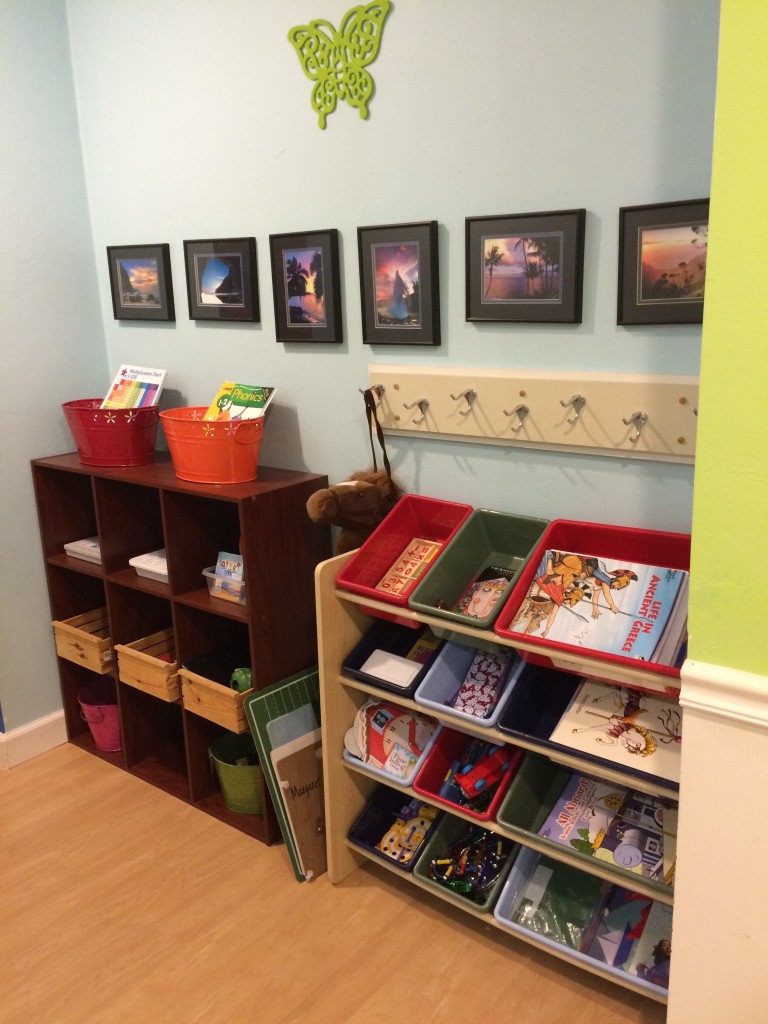
In the tubs, we each child has their own resource tubs (for The Binder, coloring books, colored pencils, etc.) and we have a few learning activities (a time telling game, math sticks, Goldie Blox, etc.).
In the cube system we rotate brain games and small building toys. The 2 buckets on top of the cubes are for language arts and math resources that are presently in use.
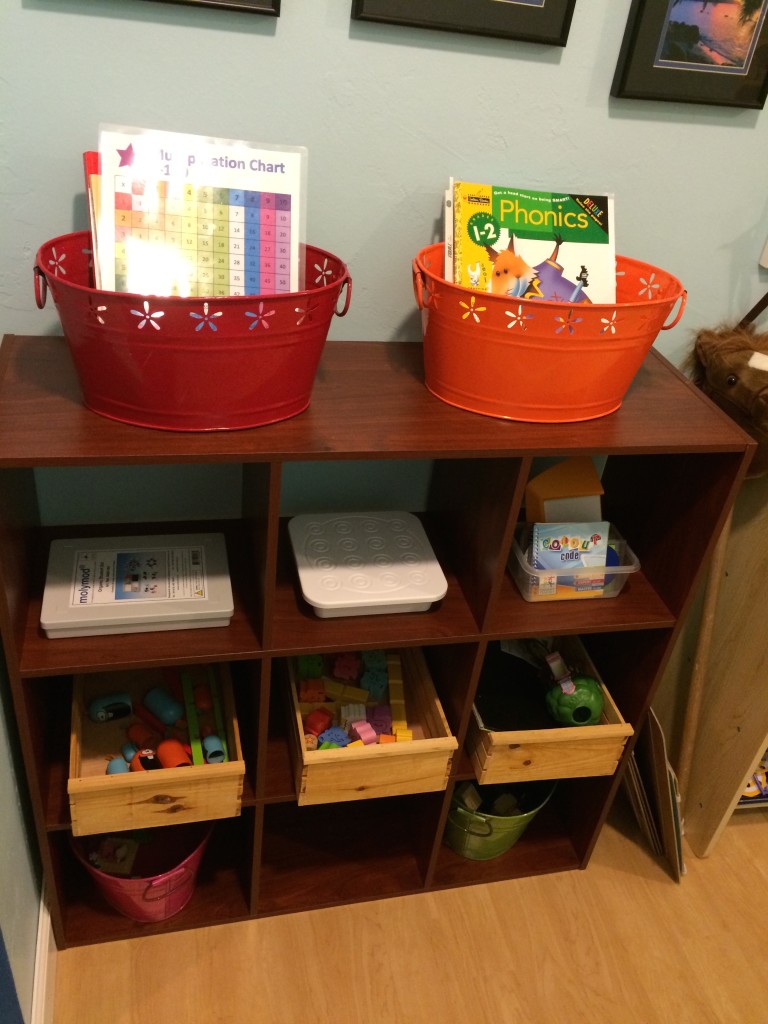
These are very tidy because they are very logical. It requires very little supervision from me to keep them orderly because the are so task specific. A little bit of good habit development and the kids will naturally love to keep their work things very nice. 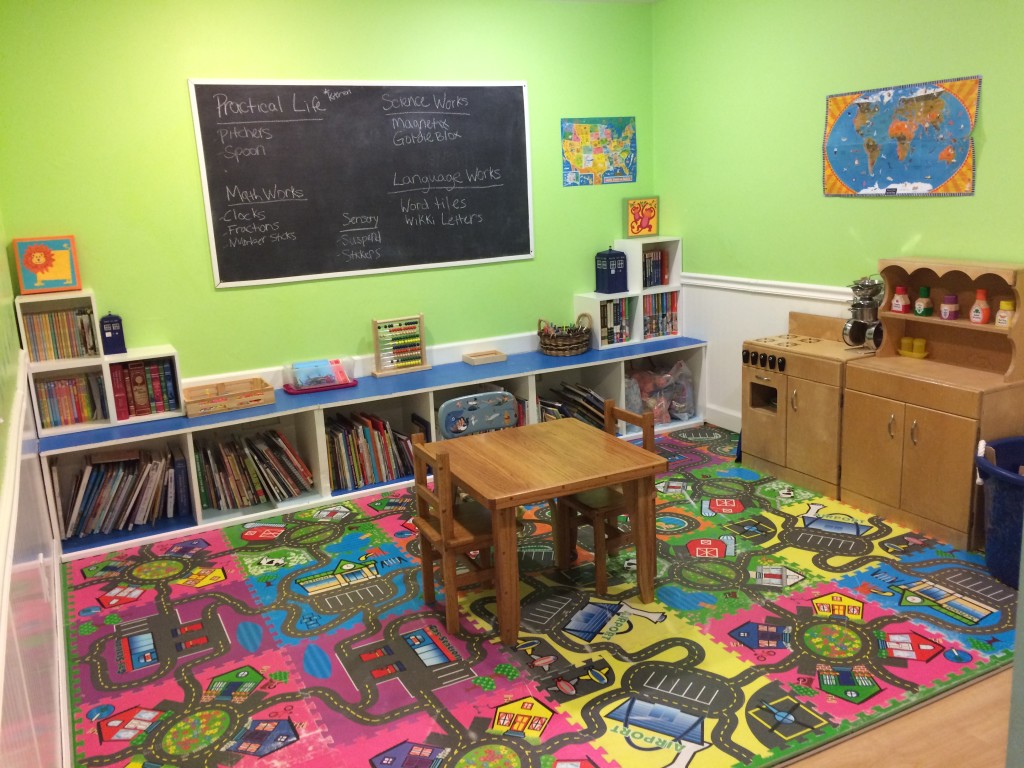
In our old playroom we have 3 ideas mashed together. First, my kids claimed the playroom as their own Core library (I wrote about it here). They filled those shelves and while I give them some input and make a few recommendations, they are very proud of their library and keep it in pretty decent repair. Please ignore the flooring… let’s just say that that is a complicated budget issue that I must just submit to. 🙂
In one cubby we are storing “fort making” supplies. 🙂 No children’s space is complete without forts! Whovian friends: yes, we have more than 1 tardis in that room – necessary, right? This one is our pencil holder (cookie jar repurposed). The other is the Doctor Who Yahtzee game.
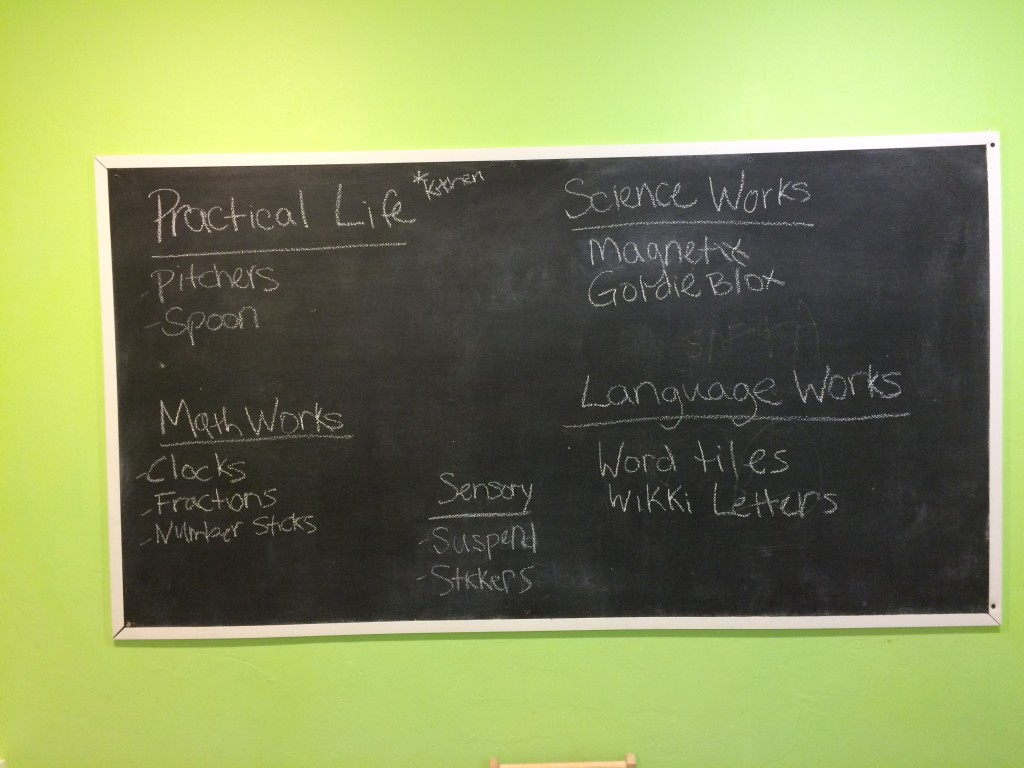 I do have pretty poor blackboard handwriting…. but that’s on my list for “you not them”. 😉 The number of learning activities, brain games and skill building resources I have can not all be accessible to my kids all at once and all of the time. First of all, the volume is inadequate to the space that we have. Secondly, it is stimulation overload or as Jennifer Cooke O’Toole says in Asperkids, it is “visual noise”. Too much of a good thing is still too much; no matter how good. So, using a loose interpretation of Montessori “works,” I give my children 2 or 3 choices for each of the main areas each week. The other resources are stored in tubs in the storage area of my basement. Leaving things out for a week or so at a time gives my children a chance to get over being initially intrigued by the activity and a chance to get bored so that they revisit the activity with a more sustained interest and creativity.
I do have pretty poor blackboard handwriting…. but that’s on my list for “you not them”. 😉 The number of learning activities, brain games and skill building resources I have can not all be accessible to my kids all at once and all of the time. First of all, the volume is inadequate to the space that we have. Secondly, it is stimulation overload or as Jennifer Cooke O’Toole says in Asperkids, it is “visual noise”. Too much of a good thing is still too much; no matter how good. So, using a loose interpretation of Montessori “works,” I give my children 2 or 3 choices for each of the main areas each week. The other resources are stored in tubs in the storage area of my basement. Leaving things out for a week or so at a time gives my children a chance to get over being initially intrigued by the activity and a chance to get bored so that they revisit the activity with a more sustained interest and creativity.
Quite to my delight, my childhood play kitchen survived and was passed down to my children. Sadly, however, it was too many pieces for our space. A beautiful hand made 4 piece kitchen set was unappealing and unwieldy. Once we realized that it was not the kitchen that my kids were constantly rejecting but the set up, I asked my mom if she would take 2 of the pieces back to her basement along with half of the playfood and kitchen things. In this way my kids will have the joy of playing with these things at her house and what remains here will be far more manageable.
Applying the same logic to the kitchenette that we apply to toys and learning activities, my children and I worked together to pare the kitchen down to just the best pieces that are parts of sets. We banished anything that wasn’t in good condition, kept what worked well with other things and stored everything in a way that was logical enough that the kids wouldn’t need much reminding about where to put things when it came to pick up time. 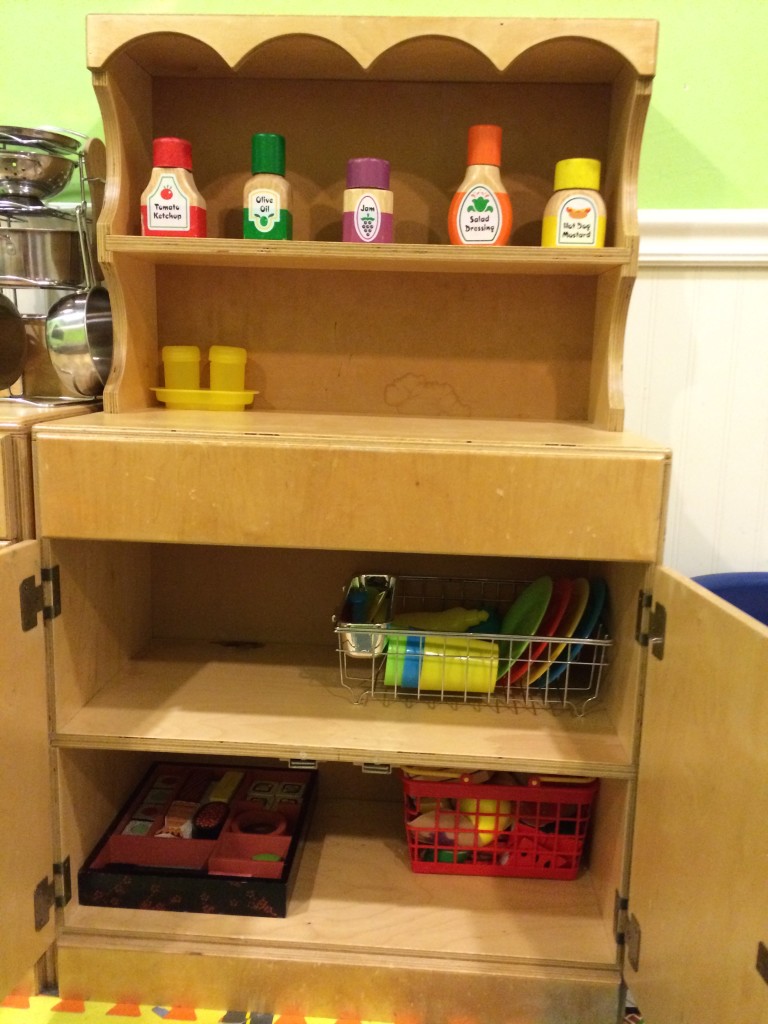
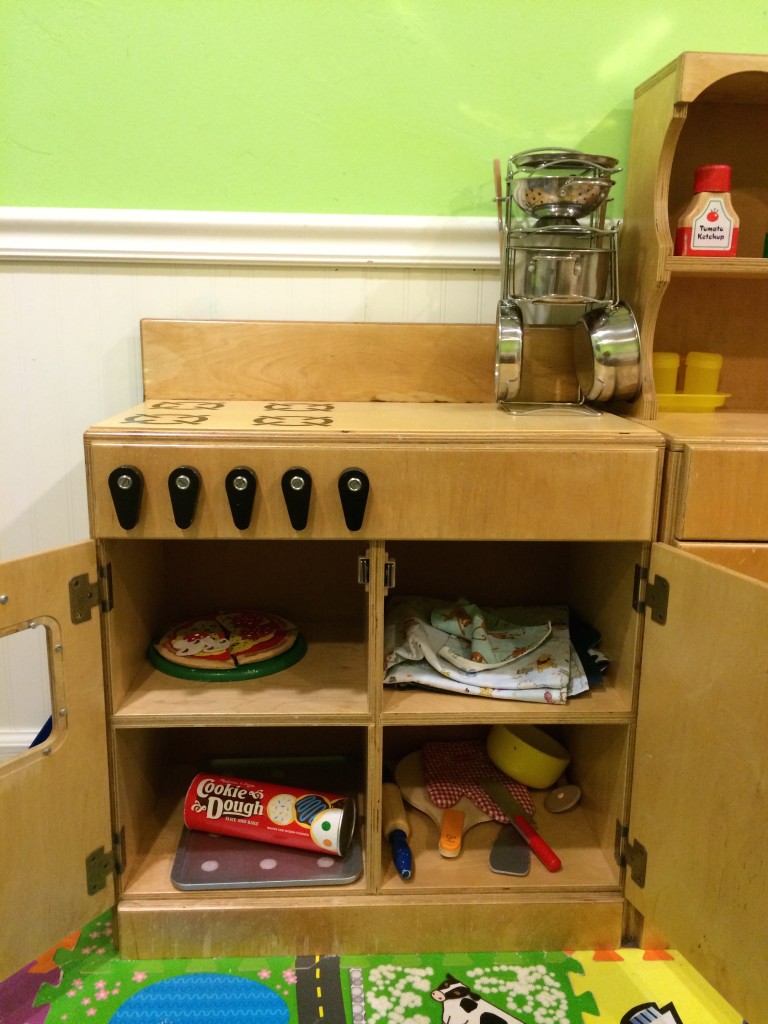 By restricting the downstairs space to specific learning centers, we needed a place for regular toys to live so that the kids could play with them. Additionally, the kids love being downstairs when I am downstairs – studying, reading, do computer work and/or working with them. When I am upstairs, however, you can guess that they all traipse back up with me. For this reason our living room lovingly welcomes toys and puzzles.
By restricting the downstairs space to specific learning centers, we needed a place for regular toys to live so that the kids could play with them. Additionally, the kids love being downstairs when I am downstairs – studying, reading, do computer work and/or working with them. When I am upstairs, however, you can guess that they all traipse back up with me. For this reason our living room lovingly welcomes toys and puzzles. 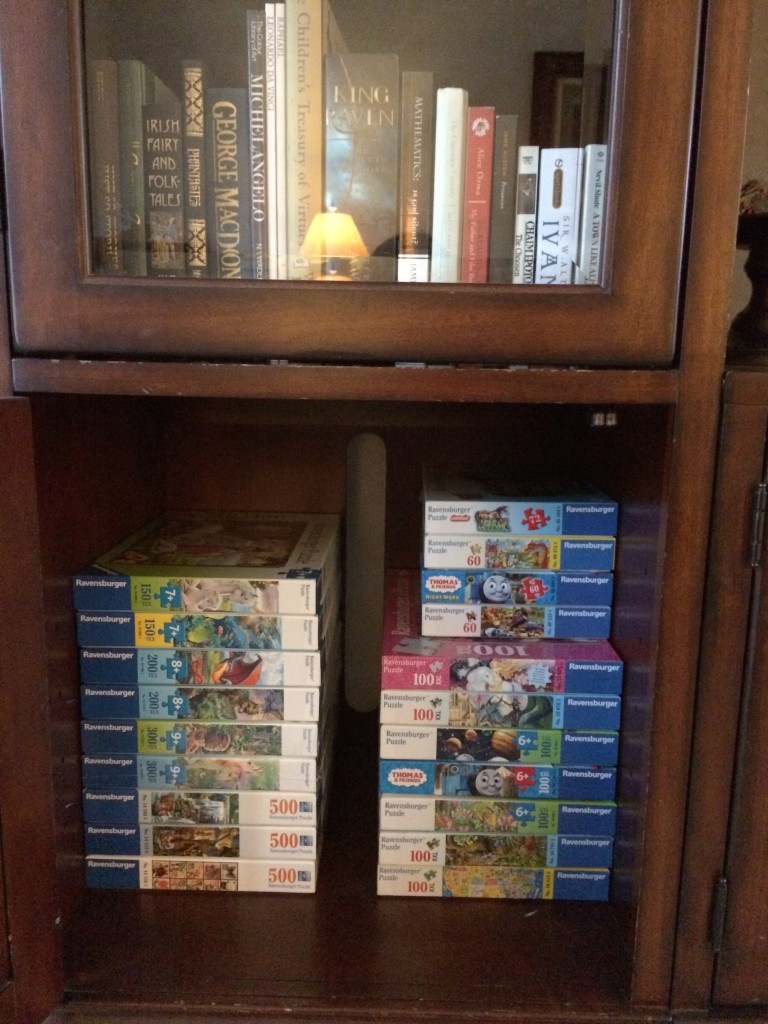 One of our book/entertainment shelves has a lower cabinet perfect for puzzles. At one time the mate to this cabinet stored a bunch of wooden tray puzzles and smaller puzzles. The reality is that we are a puzzle family and our 3 year old does 60 piece puzzles unassisted. We were able to retire that cabinet (and sell our tray puzzles) and consolidate down to just this one. As you can see, we are particular about brand. While we have purchased some other brands, we are always disappointed. We have decidedly become a Ravensburger family.
One of our book/entertainment shelves has a lower cabinet perfect for puzzles. At one time the mate to this cabinet stored a bunch of wooden tray puzzles and smaller puzzles. The reality is that we are a puzzle family and our 3 year old does 60 piece puzzles unassisted. We were able to retire that cabinet (and sell our tray puzzles) and consolidate down to just this one. As you can see, we are particular about brand. While we have purchased some other brands, we are always disappointed. We have decidedly become a Ravensburger family.
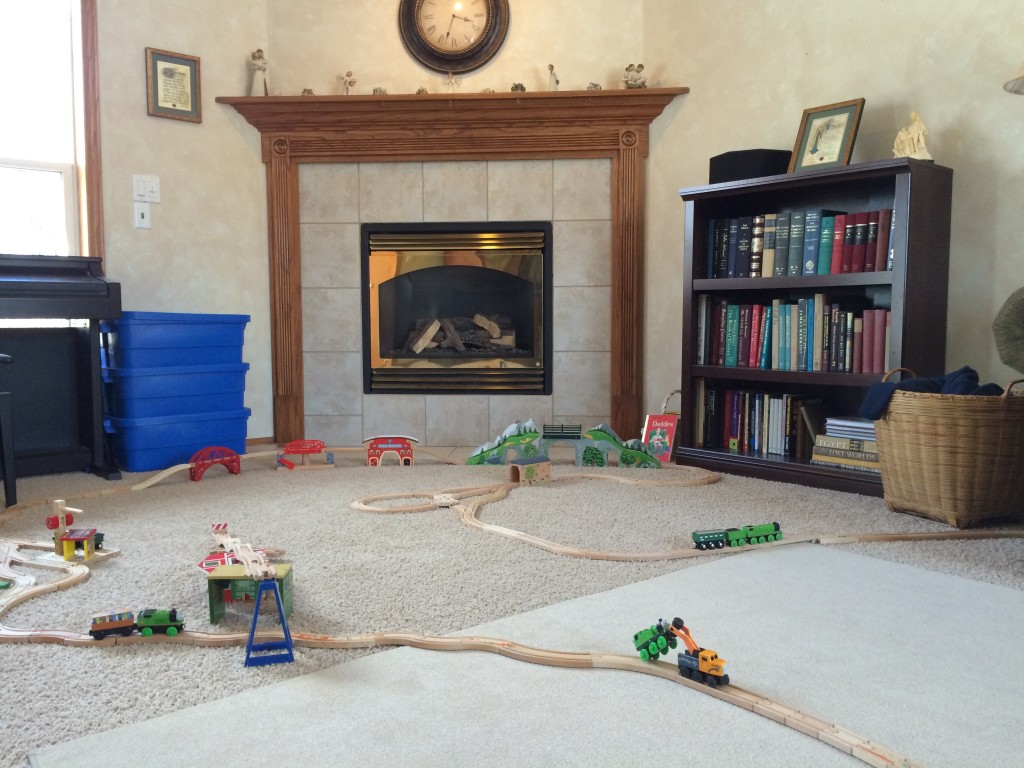 In our living room, our focus has been on as much open space as possible so that we can move, spread out and build. Each week my children each get to choose one toy system that they want in rotation. I have 3 children and so that translates into 3 tubs that live between the piano and fireplace. I have a bunch of these tubs as they have proven to be the most reliable way to stack and store toys. Each tub is labeled and the kids come into the storage side of the basement with me and “shop” from their tubs. More than 3 toy systems out at a time tends to be overwhelming. This is just about right for us. Being limited to 3 systems not only helps to control the mess but also fosters community play because there aren’t as many options. I like that fellowship.
In our living room, our focus has been on as much open space as possible so that we can move, spread out and build. Each week my children each get to choose one toy system that they want in rotation. I have 3 children and so that translates into 3 tubs that live between the piano and fireplace. I have a bunch of these tubs as they have proven to be the most reliable way to stack and store toys. Each tub is labeled and the kids come into the storage side of the basement with me and “shop” from their tubs. More than 3 toy systems out at a time tends to be overwhelming. This is just about right for us. Being limited to 3 systems not only helps to control the mess but also fosters community play because there aren’t as many options. I like that fellowship.
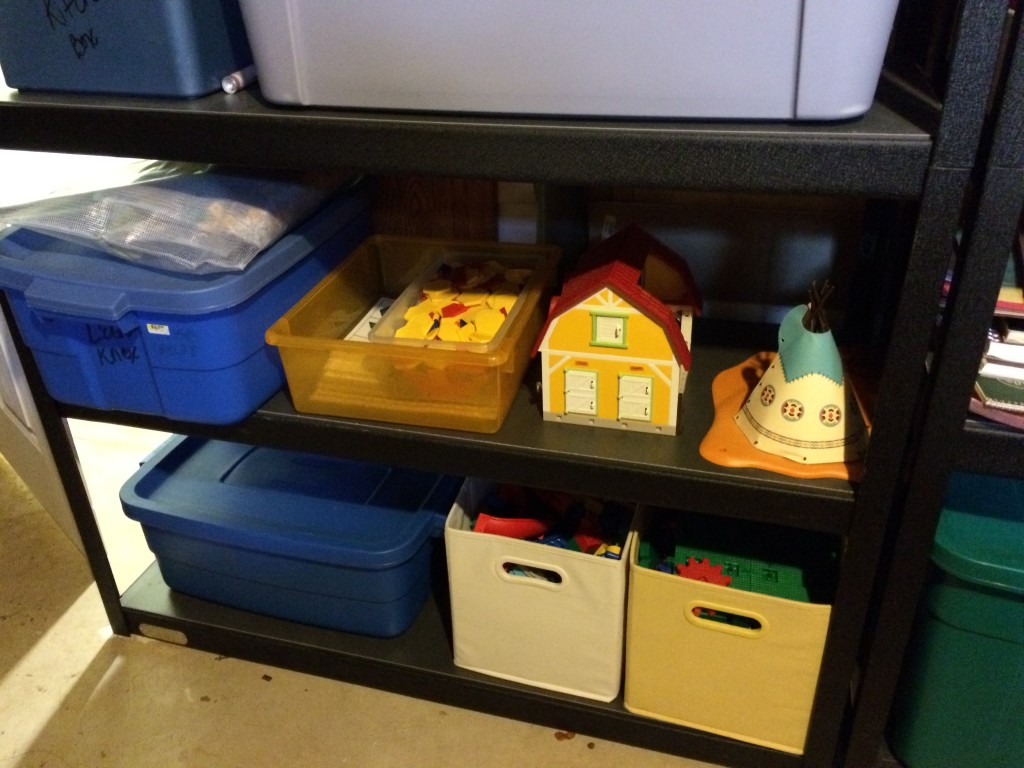 In the unfinished side of our basement we have several shelves like this and store the tubs, the big playmobil pieces and some smaller boxes of toys like duplos, gears, etc.
In the unfinished side of our basement we have several shelves like this and store the tubs, the big playmobil pieces and some smaller boxes of toys like duplos, gears, etc.
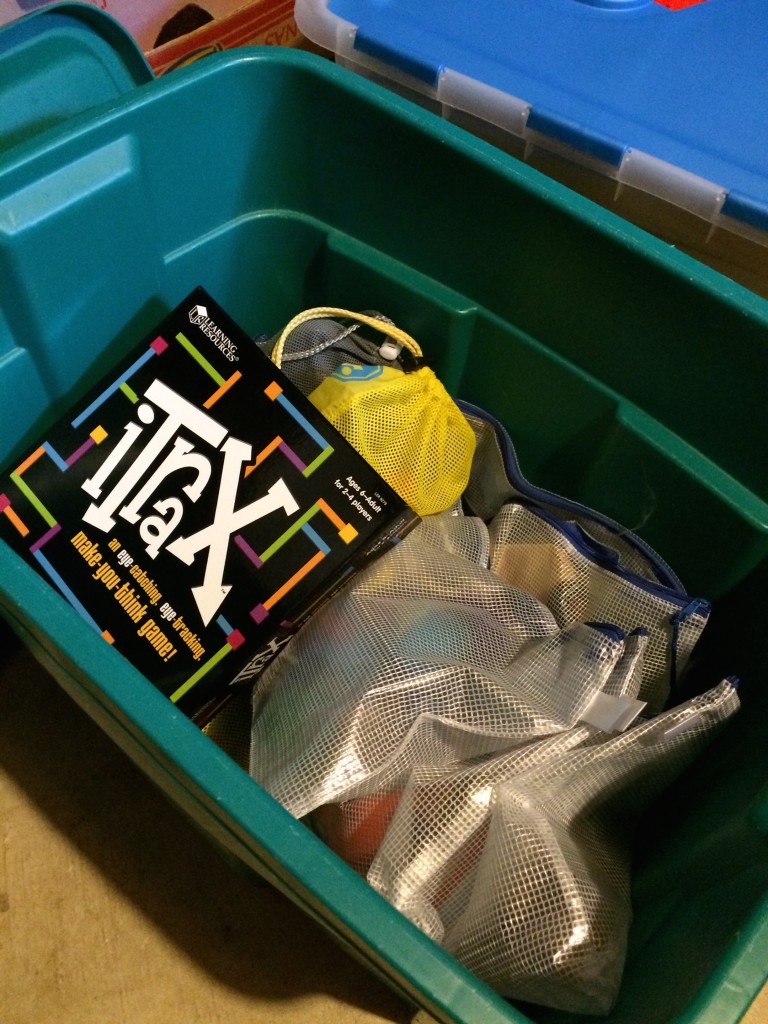 I choose which brain games rotate into the cubes each week. Many of the brain games come in neat mesh bags but for those which do not, I purchased these zippered heavy duty plastic bags. They are wonderful for storing all kinds of things. I store all of the brain games in one big tub.
I choose which brain games rotate into the cubes each week. Many of the brain games come in neat mesh bags but for those which do not, I purchased these zippered heavy duty plastic bags. They are wonderful for storing all kinds of things. I store all of the brain games in one big tub.
Likewise, I store all of the “Montessori works” in their own tub for easy rotation in and out.
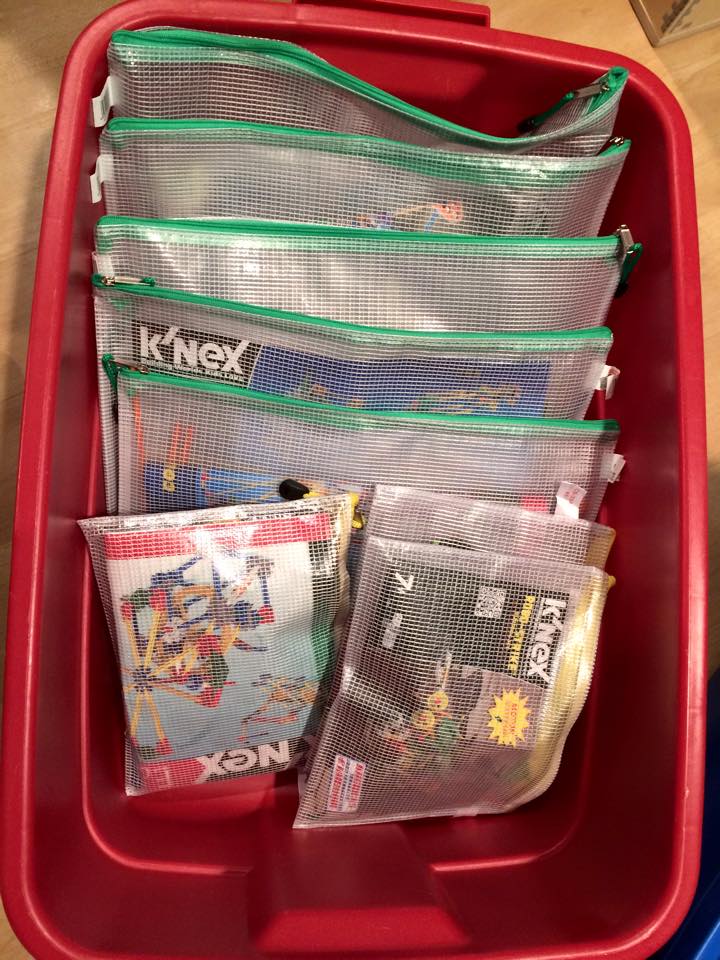 In the K’nex and Lego tubs, each construction set is in it’s own zippered bag. Generic bricks and pieces are sorted by color.
In the K’nex and Lego tubs, each construction set is in it’s own zippered bag. Generic bricks and pieces are sorted by color.
We are all loving this organization. Clean up is a cinch because everything makes sense and there isn’t too much of anything to make it overwhelming.
I can honestly admit that my husband and I each brought a lot of board games to the marriage that are not organized! That is the next project!

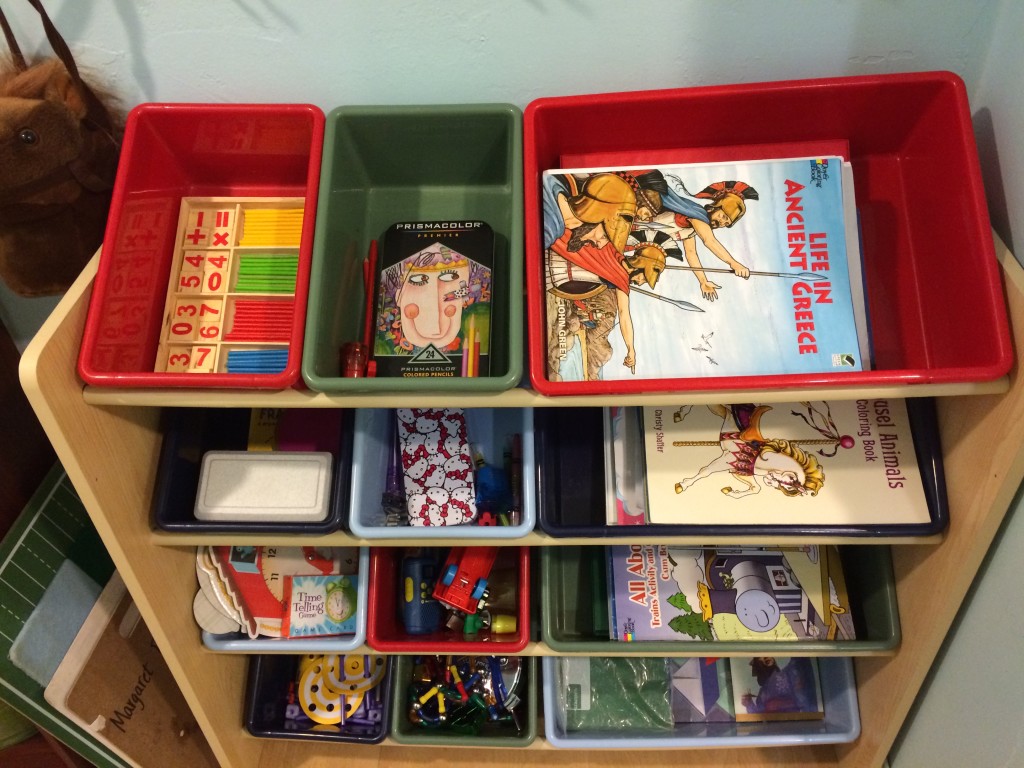
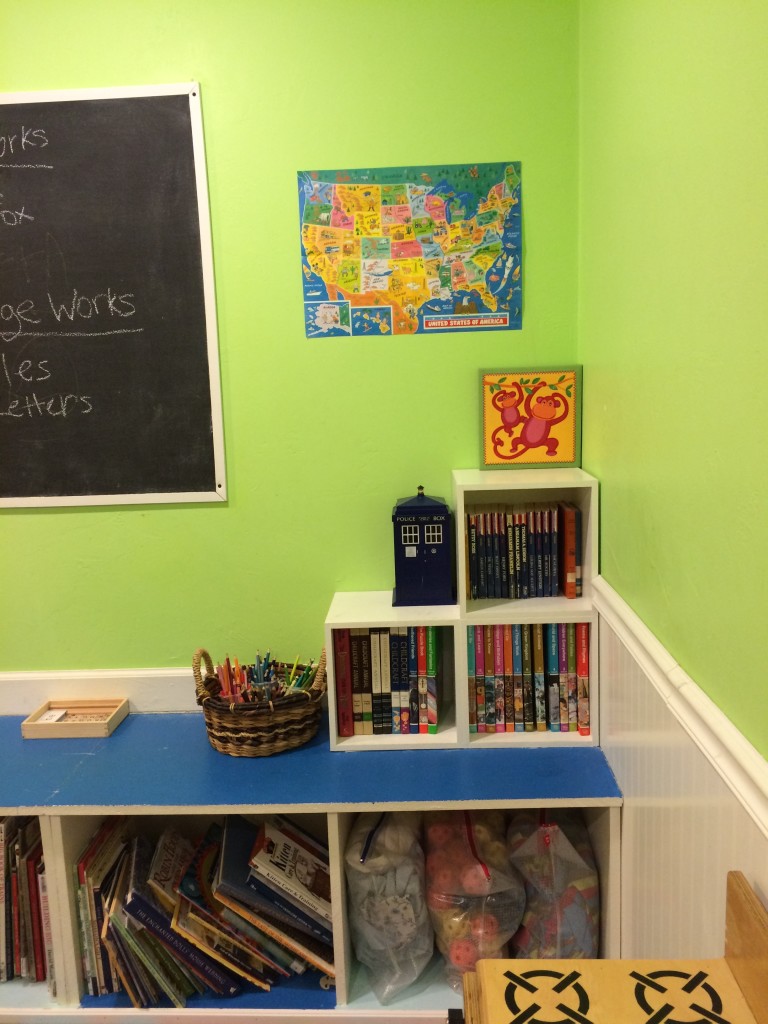
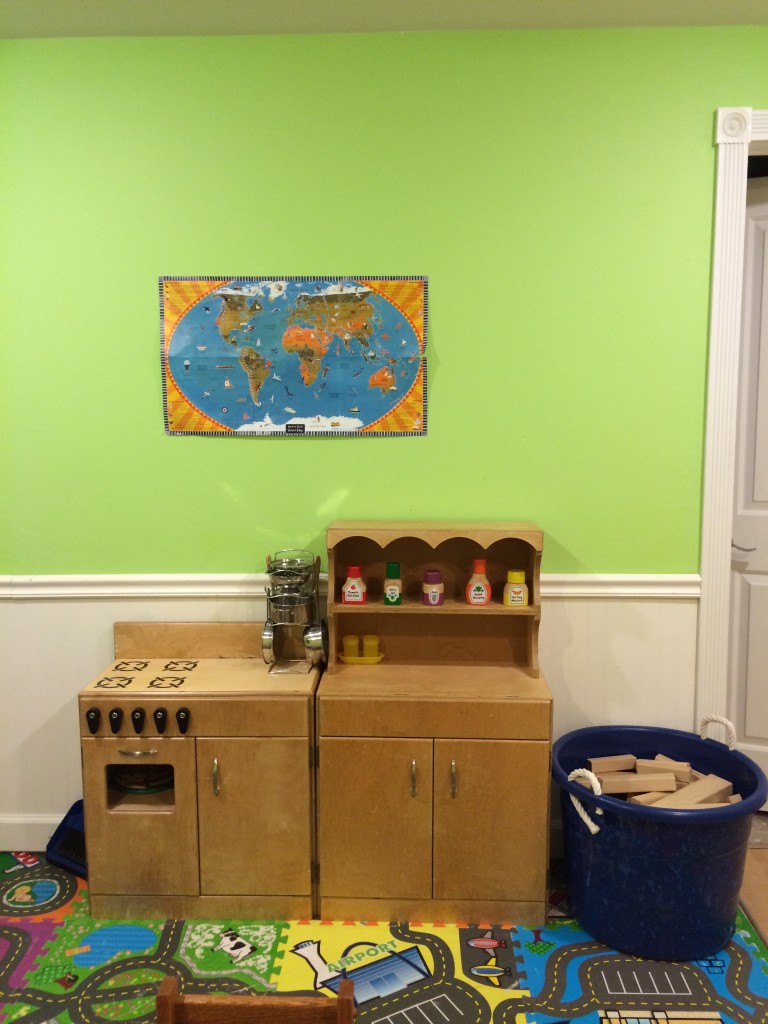
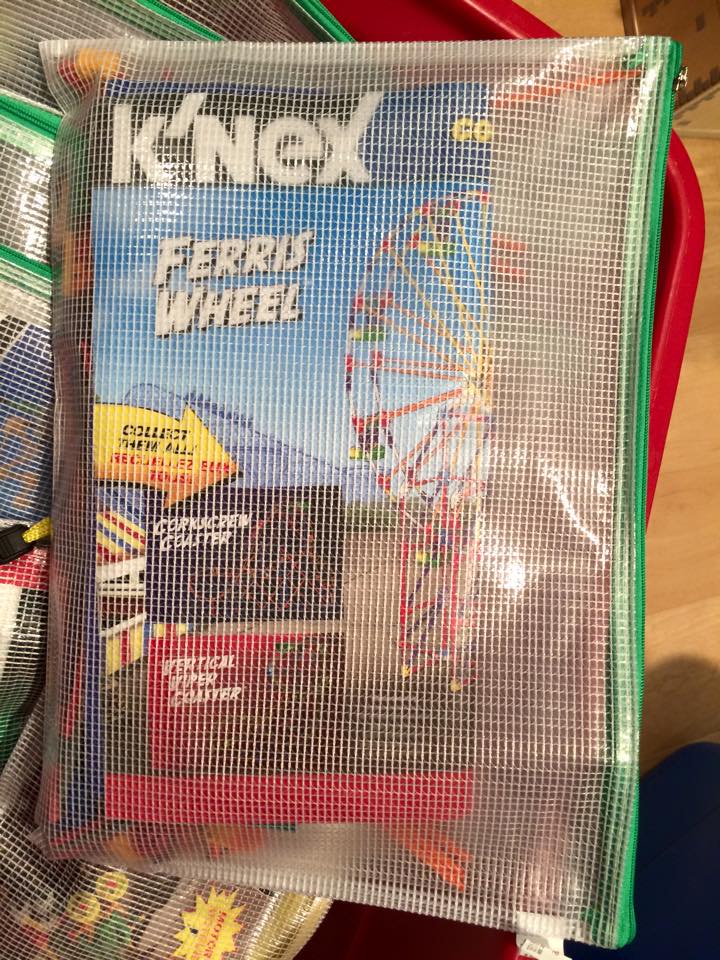
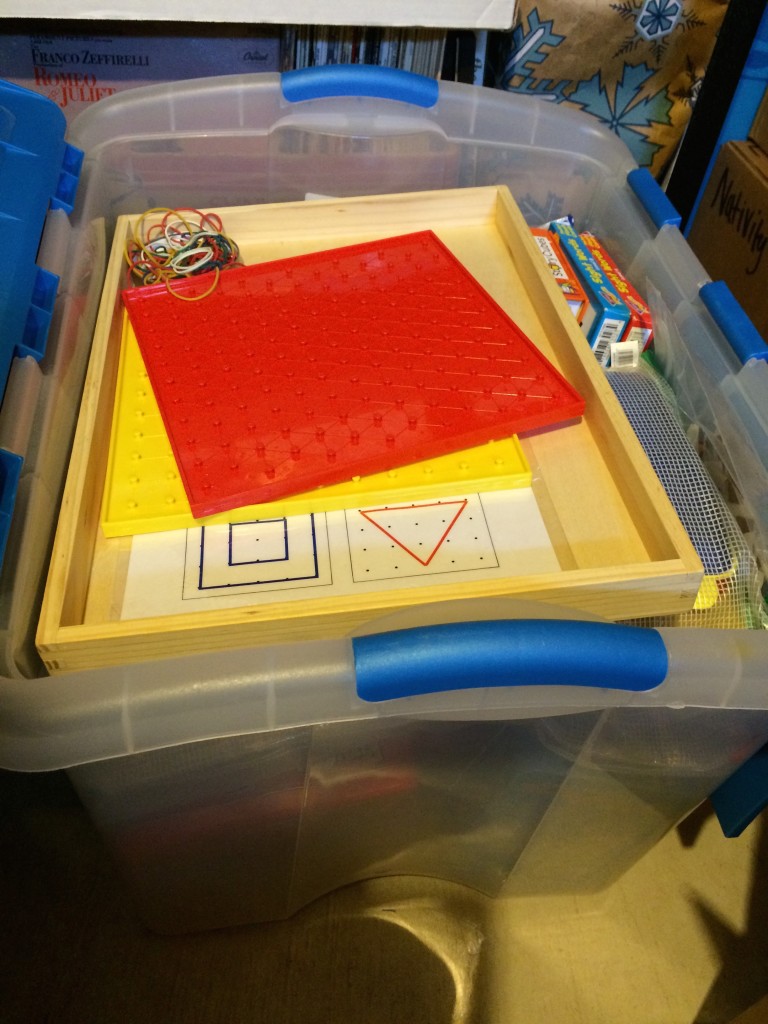
It makes me so happy to see how much Montessori you have adopted! 🙂 It will make a great difference in your lives, I promise.
I have always loved Montessori but it wasn’t until TJEd that I was ready to really shed the conveyor belt. Now that we are comfortable with Core and Love of Learning phases, Montessori has been the frosting on the cake!